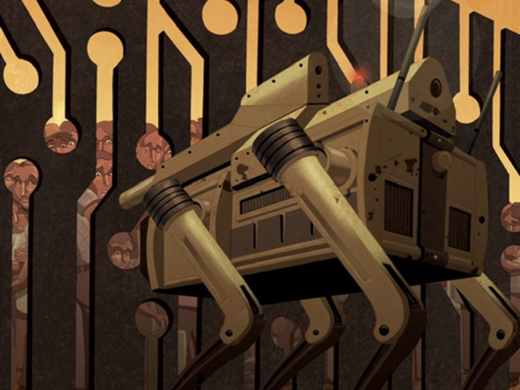Networked platforms have become critical to military operations, particularly multinational operations within the North Atlantic Treaty Organization (NATO). From enhancing battlefield situational awareness and powering autonomous weapon systems, to guiding munitions and coordinating multi-domain operations, digital technologies are moving warfare into the network era. Digital platforms now underpin communication, data processing and information sharing on a global basis and with precise detail.
This has enormous implications for the future of warfare.
Beginning with the network-centric military operations of the 1990s, digital technologies have become pivotal to advanced weapons, tactics and planning across robust cloud platforms. The increasing complexity of war means that large numbers of actors, vast quantities of data, expanding lines of authority and complex geographical environments require an extensive use of algorithms to “augment” military operations. In a digitized battlespace, every soldier, resource and weapon system is now a node within a multidimensional military network.
Where layers of bureaucracy once configured decision making, digital platforms and data-driven applications are now fundamental to amplifying military operations. The use of sensors and satellite networks to collect, transmit and process massive amounts of data has become critical to bridging land, sea, air and space domains. Data helps coordinate air strikes, pilot drones, surveil the battle space and administer highly complex resource supply chains. In the context of modern warfare, data fuels the OODA (observe-orient-decide-act) loop.
Building a Secure Military Cloud
As nation-states scramble to develop secure operating platforms to reduce the threat of cyberwar, modern militaries are now focused on cloud computing. In the United States, the Department of Defence has begun developing what it calls the Joint Warfighting Cloud Capability. Working with the country’s largest cloud service providers (Amazon, Microsoft, Google), the US military has begun a comprehensive process of transforming a highly complex and unwieldy military enterprise into an enterprise-scale network built around data-driven platforms.
Enterprise-scale networks make it possible to target, track, visualize and coordinate highly varied resources across complex organizational environments. NATO itself has selected the French multinational company Thales to provide its first defence cloud infrastructure. Supporting a fully certified solution for end-to-end connectivity, the Nexium Defence Cloud is expected to analyze and share data in real time from command centres to the battlefield, accelerating the decision cycle in the evolution of modern warfare.
In the context of a changing global order, technological change means that military modernization is becoming “computational” and highly competitive. However, unlike past technological developments (for example, atomic weapons or stealth aircraft), no country will have a monopoly on digital technologies. Indeed, given that most advances in this area are now driven by industry rather than government, future military technologies will likely proliferate across a competitive global market.
The AI Revolution
In fact, competition across a rising multipolar order is accelerating the pace at which governments invest in advanced technologies — particularly artificial intelligence (AI). In the United States, the software contractor Palantir is now using generative AI to harvest data across its recently released Artificial Intelligence Platform (AIP). Like ChatGPT, AIP uses machine learning to provide military operators with private communication networks to better administer conventional battlefield resources (such as drones, satellite imagery, supply chains and so on).
A number of militaries today are investing enormous sums in the development and adoption of data-driven technologies. Much as developments in rubber processing and the steel industry converged with the invention of the internal combustion engine to remake transportation and the design of cities, advances in AI and robotics promise to transform the nature of national defence and security. Indeed, AI is already being used to pilot drones, gather intelligence and target enemy positions. AI is no silver bullet but, together with cloud platforms, its applications will dramatically expand military capabilities.
Forecasts suggest that global economic gains driven by the technology could be as a high as $15.7 trillion in 2030. China, in particular, hopes to lead the world in AI and expects to widen its lead in the industrialization process by harnessing that country’s massive abundance of data. It seems likely that the sheer scale of China’s technology industry will drive a rapid rise in Chinese AI and Chinese military technologies as well.
Moving at the Speed of Data
Notwithstanding that technological innovation has always shaped the nature of warfare, the scale and velocity of contemporary technological change are unprecedented. Like sedimentary layers, each breakthrough enables ever-more-powerful innovations to emerge atop previous generations of technological achievement. And as each new substrate builds on the last, new disruptive technologies take root. As these technological building blocks continue to fuel the convergence of human and machine intelligence, they will reshape the fabric of modern militaries and modern societies as well.
The upshot is that a vast creative explosion in commercial applications overlapping robotics, battery storage, space-based telecommunications, cloud computing and AI is reshaping the global order. Militaries are now challenged to move faster and make better decisions even as the time scale between idea and initial operational capability keeps shrinking.
Given the inherent risks in deploying new augmented military technologies and systems, military leaders will need to understand the ramifications of accelerating the OODA loop to speeds that potentially exceed human capabilities. As data grows in importance, so does adversarial competition across an increasingly complex innovation landscape.



